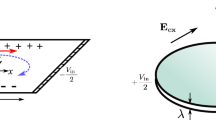Abstract
The rotation of suspended liquid films induced by electric fields has been reported. The liquid film rotates when there is an electric current passing through the suspended film and simultaneously there is an external electric field which is perpendicular to the electric current. In this study, we propose an explanation of the phenomenon based on the electrical forces actuating on the charges induced on the free surface of an ohmic liquid. We describe the electrical and hydrodynamic equations and solve them numerically by using finite elements. The numerical results are compared with the experiments, and good agreement is found.









Similar content being viewed by others
References
Amjadi A, Shirsavar R, Radja NH, Ejtehadi MR (2009) A liquid film motor. Microfluid Nanofluid 6(5):711–715
Arifin DR, Yeo LY, Friend JR (2007) Microfluidic blood plasma separation via bulk electrohydrodynamic flows. Biomicrofluidics 1:014103
Bonhomme O, Liot O, Biance A-L, Bocquet L (2013) Soft nanofluidic transport in a soap film. Phys Rev Lett 110(5):054502
Castellanos A (1998) Electrohydrodynamics, vol 380. Springer, Berlin
Daya ZA, Morris SW, De Bruyn JR (1997) Electroconvection in a suspended fluid film: a linear stability analysis. Phys Rev E 55(3):2682
Faetti S, Fronzoni L, Rolla PA (1983) Electrohydrodynamic domain patterns in freely suspended layers of nematic liquid crystals with negative dielectric anisotropy. J Chem Phys 79(3):1427–1433
Fuhr G, Hagedorn R, Muller T, Benecke W, Wagner B (1992) Microfabricated electrohydrodynamic (EHD) pumps for liquids of higher conductivity. Microelectromech Syst J 1(3):141–146
Grosu FP, Bologa MK (2010) Electroconvective rotation of a dielectric liquid in external electric fields. Surf Eng Appl Electrochem 46(1):43–47
Hughes MP (2000) AC electrokinetics: applications for nanotechnology. Nanotechnology 11(2):124
Lee J, Moon H, Fowler J, Schoellhammer T, Kim C-J (2002) Electrowetting and electrowetting-on-dielectric for microscale liquid handling. Sens Actuators A Phys 95(2):259–268
Light TS, Kingman B, Bevilacqua AC (1995) The conductivity of low concentrations of CO2 dissolved in ultrapure water from 0–100 °C. In: Proceedings of 209th American Chemical Society National Meeting, pp 2–6
Liu Z-Q, Zhang G-C, Li Y-J, Jiang S-R (2012) Water film motor driven by alternating electric fields: its dynamical characteristics. Phys Rev E 85(3):036314
Manz A, Graber N, Widmer HM (1990) Miniaturized total chemical analysis systems: a novel concept for chemical sensing. Sens Actuators B Chem 1(1):244–248
Melcher JR, Taylor GI (1969) Electrohydrodynamics: a review of the role of interfacial shear stresses. Ann Rev Fluid Mech 1(1):111–146
Morris SW, de Bruyn JR, May AD (1990) Electroconvection and pattern formation in a suspended smectic film. Phys Rev Lett 65(19):2378
Newman J, Karen E (2012) Electrochemical systems. Wiley, New York
Pearson MR, Seyed-Yagoobi J (2011) Experimental study of EHD conduction pumping at the meso-and micro-scale. J Electrostat 69(6):479–485
Petkov JT, Danov KD, Denkov ND, Aust R, Durst F (1996) Precise method for measuring the shear surface viscosity of surfactant monolayers. Langmuir 12(11):2650–2653
Prasad V, Weeks ER (2009) Flow fields in soap films: relating viscosity and film thickness. Phys Rev E 80:026309
Ramos A, Morgan H, Green NG, Castellanos A (1999) Ac electric-field-induced fluid flow in microelectrodes. J Colloid Interface Sci 217(2):420–422
Richter, A, Sandmaier, H (1990) An electrohydrodynamic micropump. In: Proceedings of micro electro mechanical systems, 1990. An investigation of micro structures, sensors, actuators, machines and robots. IEEE, pp 99–104
Rutgers MA, Wu XL, Daniel WB (2001) Conducting fluid dynamics experiments with vertically falling soap films. Rev Sci Instrum 72(7):3025–3037
Saville DA (1997) Electrohydrodynamics: the Taylor–Melcher leaky dielectric model. Ann Rev Fluid Mech 29(1):27–64
Segur JB, Oberstar HE (1951) Viscosity of glycerol and its aqueous solutions. Ind Eng Chem 43(9):2117–2120
Shiryaeva EV, Vladimirov VA, Zhukov MY (2009) Theory of rotating electrohydrodynamic flows in a liquid film. Phys Rev E 80(4):041603
Shirsavar R, Amjadi A, Tonddast-Navaei A, Ejtehadi MR (2011) Electrically rotating suspended films of polar liquids. Exp Fluids 50(2):419–428
Shirsavar R, Amjadi A, Ejtehadi MR, Mozaffari MR, Feiz MS (2012) Rotational regimes of freely suspended liquid crystal films under electric current in presence of an external electric field. Microfluid Nanofluid 13(1):83–89
Sonin AA (1998) Freely suspended liquid crystalline films. Wiley, New York
Stevenson P (2005) Remarks on the shear viscosity of surfaces stabilised with soluble surfactants. J Colloid Interface Sci 290(2):603–606
Stone HA, Stroock AD, Ajdari A (2004) Engineering flows in small devices: microfluidics toward a lab-on-a-chip. Ann Rev Fluid Mech 36:381–411
Squires TM, Quake SR (2005) Microfluidics: fluid physics at the nanoliter scale. Rev Mod Phys 77(3):977–1026
Toner M, Irimia D (2005) Blood-on-a-chip. Ann Rev Biomed Eng 7:77–103
Van Nierop EA, Scheid B, Stone HA (2008) On the thickness of soap films: an alternative to Frankel’s law. J Fluid Mech 602:119
Yao S, Santiago JG (2003) Porous glass electroosmotic pumps: theory. J Colloid Interface Sci 268(1):133–142
Acknowledgments
A.R. acknowledges financial support from Spanish Government Ministry MEC under Contract No. FIS2011- 25161.
Author information
Authors and Affiliations
Corresponding author
Rights and permissions
About this article
Cite this article
Nasiri, M., Shirsavar, R., Saghaei, T. et al. Simulation of liquid film motor: a charge induction mechanism. Microfluid Nanofluid 19, 133–139 (2015). https://doi.org/10.1007/s10404-015-1555-7
Received:
Accepted:
Published:
Issue Date:
DOI: https://doi.org/10.1007/s10404-015-1555-7




